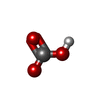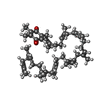+Search query
-Structure paper
| Title | Structural insights into photosystem II assembly. |
|---|---|
| Journal, issue, pages | Nat Plants, Vol. 7, Issue 4, Page 524-538, Year 2021 |
| Publish date | Apr 12, 2021 |
 Authors Authors | Jure Zabret / Stefan Bohn / Sandra K Schuller / Oliver Arnolds / Madeline Möller / Jakob Meier-Credo / Pasqual Liauw / Aaron Chan / Emad Tajkhorshid / Julian D Langer / Raphael Stoll / Anja Krieger-Liszkay / Benjamin D Engel / Till Rudack / Jan M Schuller / Marc M Nowaczyk /    |
| PubMed Abstract | Biogenesis of photosystem II (PSII), nature's water-splitting catalyst, is assisted by auxiliary proteins that form transient complexes with PSII components to facilitate stepwise assembly events. ...Biogenesis of photosystem II (PSII), nature's water-splitting catalyst, is assisted by auxiliary proteins that form transient complexes with PSII components to facilitate stepwise assembly events. Using cryo-electron microscopy, we solved the structure of such a PSII assembly intermediate from Thermosynechococcus elongatus at 2.94 Å resolution. It contains three assembly factors (Psb27, Psb28 and Psb34) and provides detailed insights into their molecular function. Binding of Psb28 induces large conformational changes at the PSII acceptor side, which distort the binding pocket of the mobile quinone (Q) and replace the bicarbonate ligand of non-haem iron with glutamate, a structural motif found in reaction centres of non-oxygenic photosynthetic bacteria. These results reveal mechanisms that protect PSII from damage during biogenesis until water splitting is activated. Our structure further demonstrates how the PSII active site is prepared for the incorporation of the MnCaO cluster, which performs the unique water-splitting reaction. |
 External links External links |  Nat Plants / Nat Plants /  PubMed:33846594 / PubMed:33846594 /  PubMed Central PubMed Central |
| Methods | EM (single particle) |
| Resolution | 2.66 - 2.72 Å |
| Structure data | EMDB-12335, PDB-7nho: EMDB-12336, PDB-7nhp: EMDB-12337, PDB-7nhq: |
| Chemicals |  ChemComp-FE:  ChemComp-MN:  ChemComp-CL:  ChemComp-PHO:  ChemComp-CLA:  ChemComp-BCR:  ChemComp-LHG:  ChemComp-BCT:  ChemComp-LMG:  ChemComp-PL9:  ChemComp-HEM: |
| Source |
|
 Keywords Keywords | PHOTOSYNTHESIS / Membrane Protein Biogenesis Assembly Factors Photosystem II |
 Movie
Movie Controller
Controller Structure viewers
Structure viewers About Yorodumi Papers
About Yorodumi Papers










 thermosynechococcus elongatus bp-1 (bacteria)
thermosynechococcus elongatus bp-1 (bacteria)